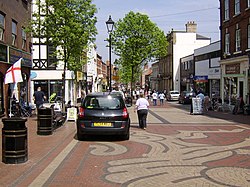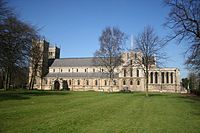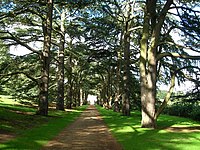Worksop
| Worksop | |
| Nottinghamshire | |
|---|---|
 Down Bridge Street, Worksop | |
| Location | |
| Grid reference: | SK585795 |
| Location: | 53°18’35"N, 1°7’22"W |
| Data | |
| Population: | 39,072 |
| Post town: | Worksop |
| Postcode: | S80/S81 |
| Dialling code: | 01909 |
| Local Government | |
| Council: | Bassetlaw |
| Parliamentary constituency: |
Bassetlaw |
Worksop is a large town in northern Nottinghamshire, on the River Ryton at the northern edge of Sherwood Forest. Worksop is some 19 mles east of the City of Sheffield and its population is estimated (mid-2004) to be 39,800.
Worksop is in the area of Nottinghamshire known as "the Dukeries", so called for the number of ducal residences thereabouts, and is held up as known as the "Capital of the Dukeries" or as "Gateway to the Dukeries".
Contents
The town
Worksop was once a small town, which grew in the Industrial Revolution as the rich local coal mines were exploited to their full. It prospered in its heyday, and many buildings about the town bear witness to this time.
However, since the collapse of the coal mining industry in the 1980s, the local economy has been through difficult times and ever since the town has been trying to as it re-orientates to service industries and manufacturing. Local unemployment remains high and social problems blight parts of the town.
Industry is still strong here; an important manufacturer in the town is Premier Foods UK, which produces such as things as Batchelor's Soups and Super Noodles and Oxo; the latter made in Worksop alone. Greencore Sandwiches also have a factory. The Wilkinson UK headquarters are at JK House, Manton Wood, south of the town on the A57. Their distribution centre is an important employer.RDS Transport (known as the Flying Fridge) based at Claylands Avenue is a major employer of HGV/Van Drivers. There is also a B&Q distribution centre and a liquid chocolate manufacturing plant owned by OCG Cacao, part of Cargill.
Worksop has benefited from a large amount of new housing recently with a similar increase in businesses locating to the Worksop area, increasing the amount of jobs in the local economy.
The area is becoming increasingly popular with commuters owing to its relative proximity to the nearby cities of Sheffield, Lincoln and Nottingham.
The nearby Welbeck Estate [1] has recently announced the launch of the School of Artisan Food [1], an independent not-for-profit organisation offering diplomas in artisan food manufacture.
Unemployment levels in the area are lower than the national average, due to large number of distribution and local manufacturing companies.
History
The earliest origin of Worksop is unknown but it is presumed to have been founded as an Anglo-Saxon village. The Domesday Book of 1086 records:
"In Werchesope, Elsi (son of Caschin) had three carucates of land to be taxed. Land to eight ploughs. Roger has one plough in the demesne there, and twenty-two sokemen who hold twelve oxgangs of this land, and twenty-four villanes and eight bordars having twenty-two ploughs, and seven acres of meadow. Wood pasture two miles long, and three quarentens broad."[2]
Later, in about 1103, William de Lovetot established a castle and Augustinian priory at Worksop. Subsequently Worksop grew into a market town.
A small skirmish occurred around Worksop during the Wars of the Roses on 16 December 1460, commonly known as the Battle of Worksop.
The building of the Chesterfield Canal in 1777, and the subsequent construction of the Manchester, Sheffield and Lincolnshire Railway in 1849, both of which passed through the settlement, led to a degree of growth. Discovery of sizeable coal seams further increased interest in the area.
Coal fed the town and made it grow. Coal mining and the associated industries which clustered round it were Worksop's greastest influences, and manufacturing companies, whose factories were powered by coal.
In the 1980s, cheap, foreign coal swept away the market for British coal and the Nottinghamshire coalfield felt it more heavily than most, many of the mines closing. During the resulting coal miners' strike of 1984-1985, the Nottinghamshire miners were less keen than others, only around 20% took part, but whatever the anger generated, change was inevitable and many mines closed. Worksop took some time to reorientate itself to the new economic pattern.
Transport
Worksop lies on the A57 road with close connections to the A1 and the M1 motorway and the A60, a central position allowing goods to be transported in and out of the area. As such it is valued as transport hub and distribution centres have been set up here.
The rail links in the area are also good, as Worksop lies on the Sheffield-Lincoln line, taking travellers to places such as Sheffield, Doncaster, Meadowhall, Lincoln, Retford, Gainsborough and Shireoaks. Worksop is also the end point of the Robin Hood line, which takes travellers to Nottingham and Mansfield. On weekends trains also run to Cleethorpes and Bridlington from Worksop.
Sights about the town
Worksop Priory
Officially titled The Priory Church of Saint Mary and Saint Cuthbert, Worksop Priory is today a Church of England parish church. It commenced life as an Augustinian Priory founded in 1103. The current incumbent uses the full pre-Reformation, mediaeval title the Priory Church of Our Lady and Saint Cuthbert, Saint Giles Carburton and Our Lady Clumber
Services are held daily throughout the year. The church has a magnifcent nave and detached gatehouse.Monks at the Priory made the Tickhill Psalter, one of the finest British illuminated manuscripts of the mediæval period, now held in New York Public Library.
After the dissolution of the Monasteries the East end of the church fell into disrepair, but the local townspeople were granted the nave as a parish church. The eastern parts of the building have been restored in several phases, the most recent being in the 1970s when the architect Lawrence King rebuilt the crossing.
Clumber Park
Clumber Park, just south of Worksop is a country park now open to the public. It was enclosed as a deer park in 1709 by John Holles, Duke of Newcastle. The house was demolished in the 1930s though many features remain, including a Grade I listed Gothic Revival Chapel built by the 7th Duke of Newcastle, and a walled kitchen garden with glass houses.
The Duke gave Clumber Park to the people of Worksop and the National Trust bought it in 1946. Today it is owned by the National Trust and is open to the public.
The Park is over 3,800 acres in extent and includes woods, open heath and rolling farmland. It contains a superb, serpentine lake covering 87 acres and the longest double avenue of lime trees in Europe (pictured). The avenue extends over three miles, and was created by the 5th Duke of Newcastle in the 19th Century.
Mr Straw's House
Worksop is home to Mr Straw's House, the family home of the Straw family, which was left by the Straw brothers, William and Walter Straw when their parents died in the 1930s. The house remained unaltered until the National Trust acquired the house in the 1990s and opened it to the public.[3]
The Acorn Theatre
The Acorn Theatre is a 200-seat performing arts venue in Worksop town centre, providing a full programme of professional and amateur live theatre and folk music. It is a registered charity managed and run by volunteers,and the building has become the home of several community performing groups and a youth theatre.
The Worksop Regal
Young Potential have taken over the former Circle Arts and provide theatre and recording studio facilities in the heart of Worksop including professional live music and arts performances and a range of arts training courses and social support services. It is managed and run mainly by volunteers who believe that involvement with the arts is vital for individual and community health.
Outside links
| ("Wikimedia Commons" has material about Worksop) |
References and notes
- ↑ http://www.welbeckproject.com/estates/leisure
- ↑ White, Robert (1875) Worksop, The Dukery, and Sherwood Forest. Transcription at Nicholson, AP: Nottinghamshire History (Accessed 24 December 2005).
- ↑ Mr Straw's House by The National Trust, accessed May 28, 2006.

